Abstract
1. In normal subjects, transcranial magnetic stimulation of the hand region of the motor cortex evokes motor responses only in contralateral hand muscles at a latency of about 19-24 ms. In contrast, stimulation of the motor cortex of three mirror movement subjects evoked, nearly simultaneously, motor responses in hand muscles on both sides of the body at latencies similar to those of normal subjects. In these subjects no other neuroanatomical pathways appear to be abnormally directed across the mid-line. Thus, their mirror movements are probably due to a projection of the corticospinal tract to homologous motoneurone pools on each side of the body. 2. We reasoned that if the motor cortex contributes to the generation of long-latency stretch reflex responses then in these mirror movement subjects stretching a muscle on one side of the body should produce long-latency reflex responses in the ipsilateral and the homologous contralateral muscle. 3. To test this idea experiments were done on normal human subjects and on the subjects with mirror movements. The electromyographic (EMG) activity of the flexor pollicis longus muscle (FPL) on each side of the body was recorded. Stretch of the distal phalanx of the thumb of one hand produced a series of distinct reflex EMG responses in the ipsilateral FPL. The earliest response, when present, began at 25 ms (S.D. = 3.5 ms) and was followed by responses at 40 (S.D. = 3.9 ms) and 56 ms (S.D. = 4.3 ms). There was no difference, either in timing or intensity, between the ipsilateral FPL EMG responses of normal subjects and those of the mirror movement subjects. 4. No response of any kind was observed in the contralateral (unstretched) FPL of normal subjects. In contrast, we observed in all three mirror movement subjects EMG responses in the contralateral (unstretched) FPL beginning at 45-50 ms. The latency of this response is considerably shorter than the fastest voluntary kinaesthetic reaction time, which was on average 130 ms (S.D. = 11 ms). The contralateral long-latency EMG response observed in the mirror movement subjects was on average 30% (range 5-60%) of that on the ipsilateral side. No short-latency response (25 ms) was ever observed in the contralateral FPL of these subjects. 5. These observations are quite consistent with the idea that the long-latency stretch reflex responses of hand and finger muscles are produced, at least in part, by the motor cortex.
Full text
PDF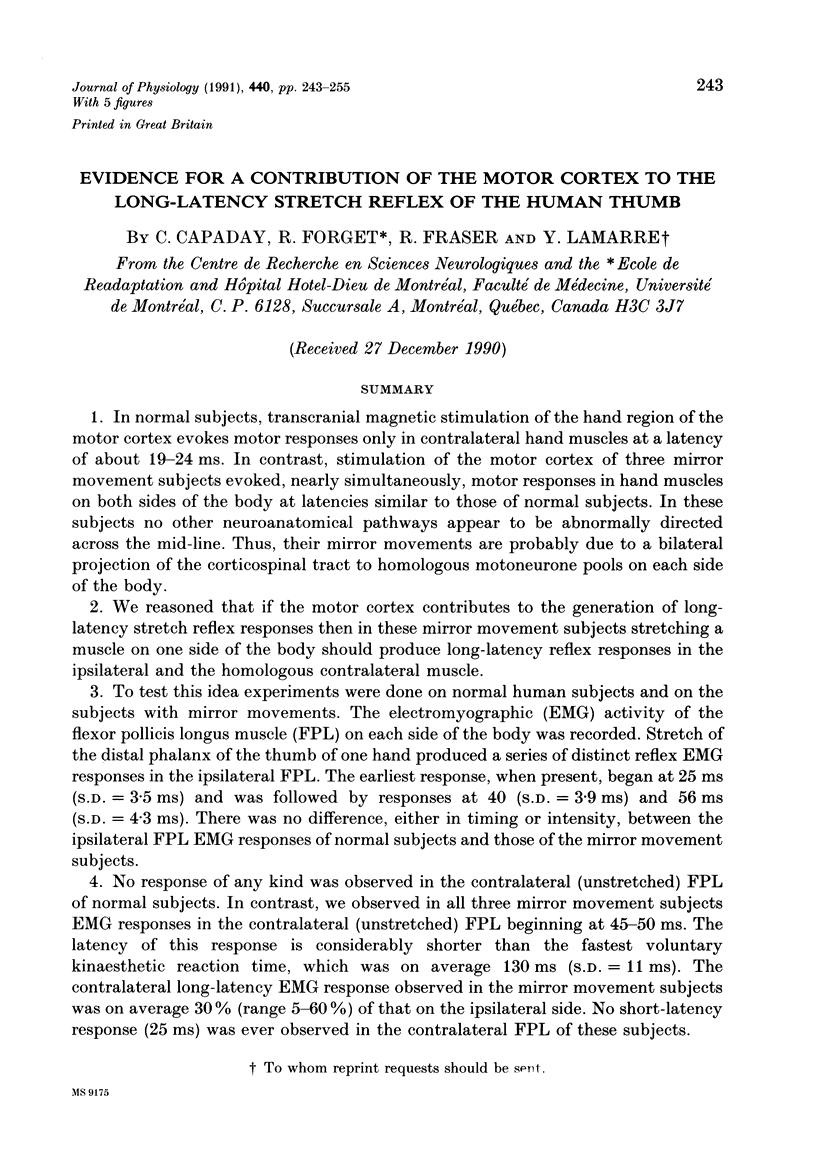
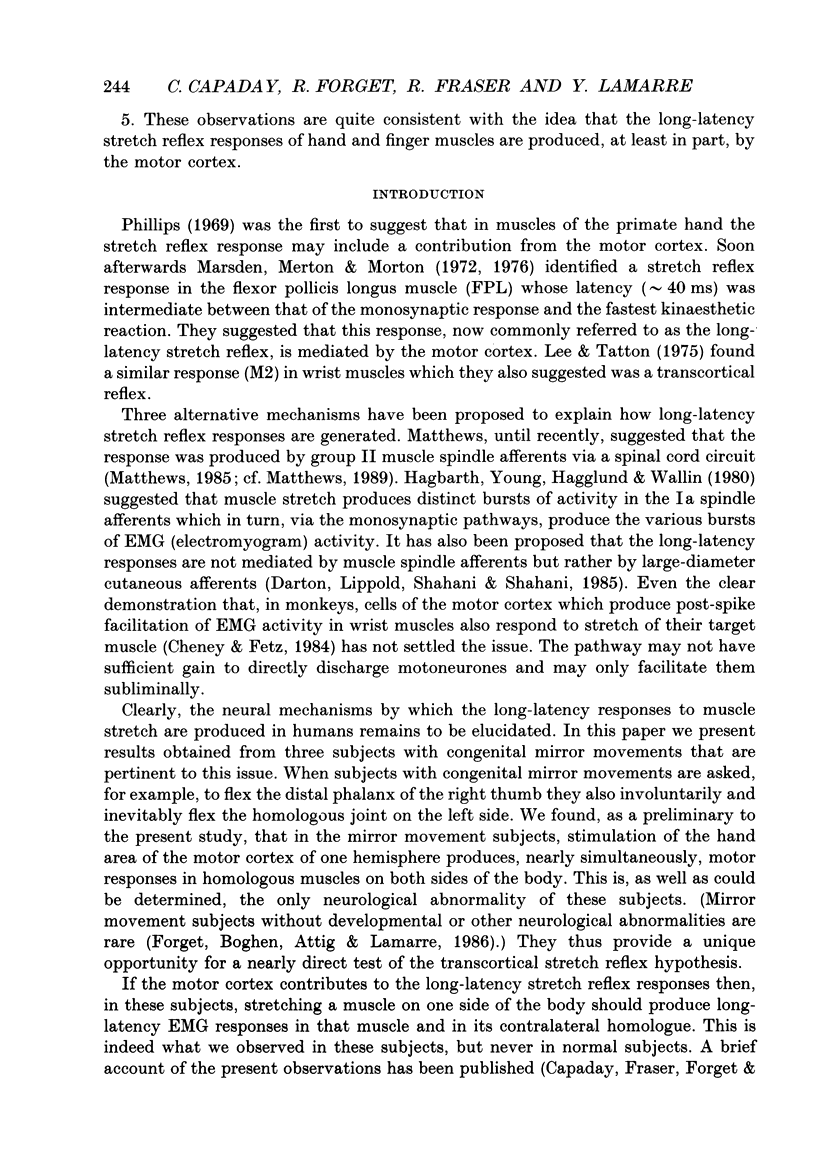
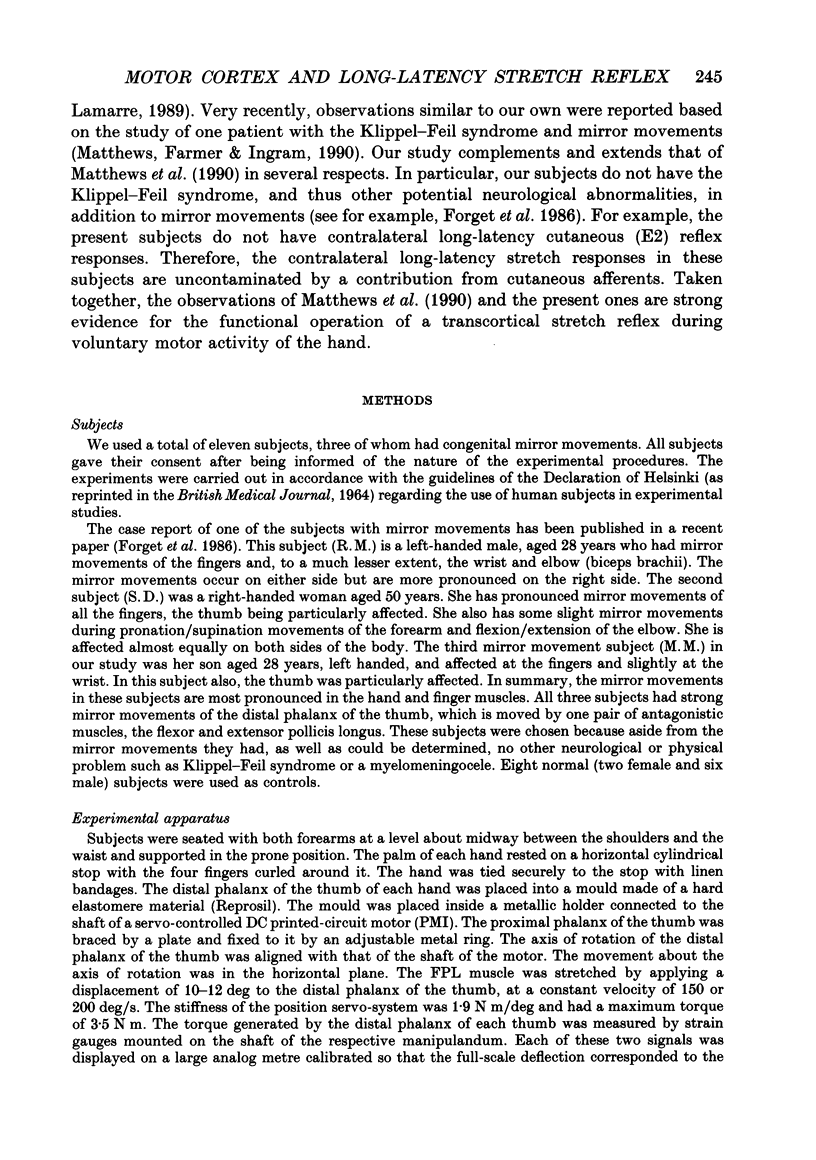
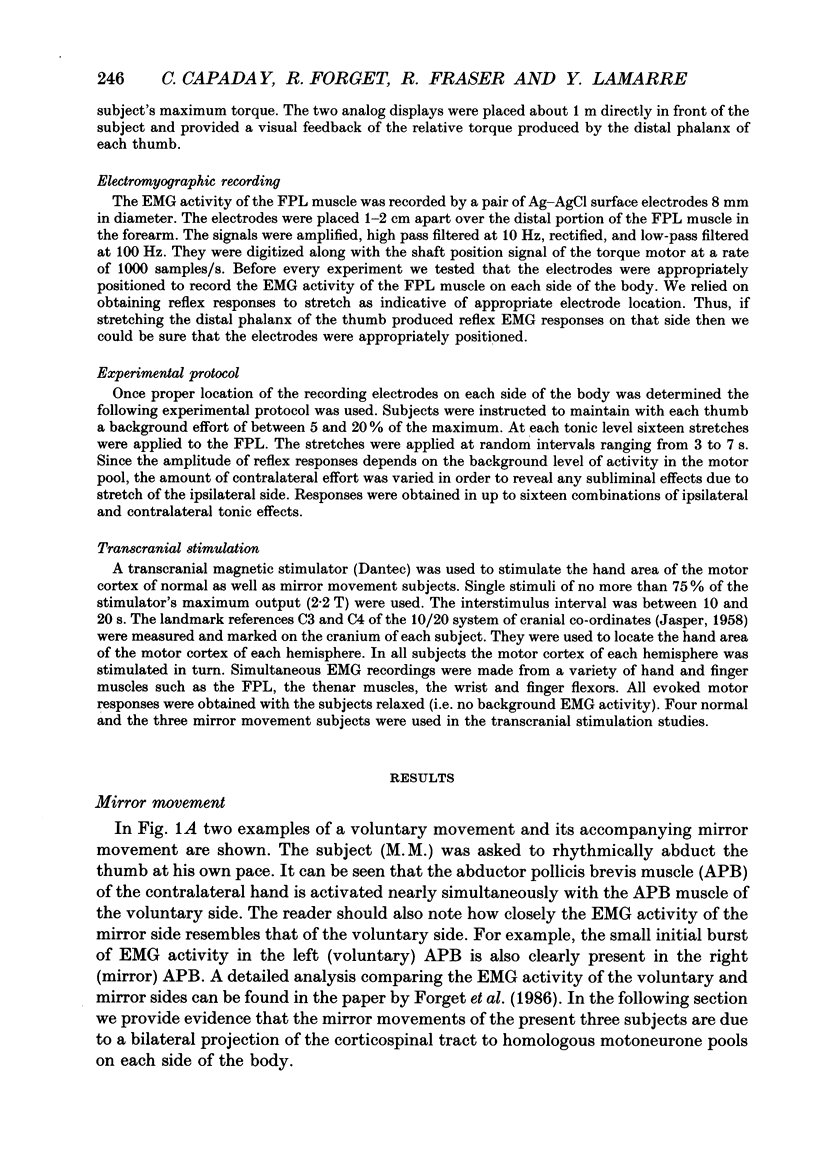
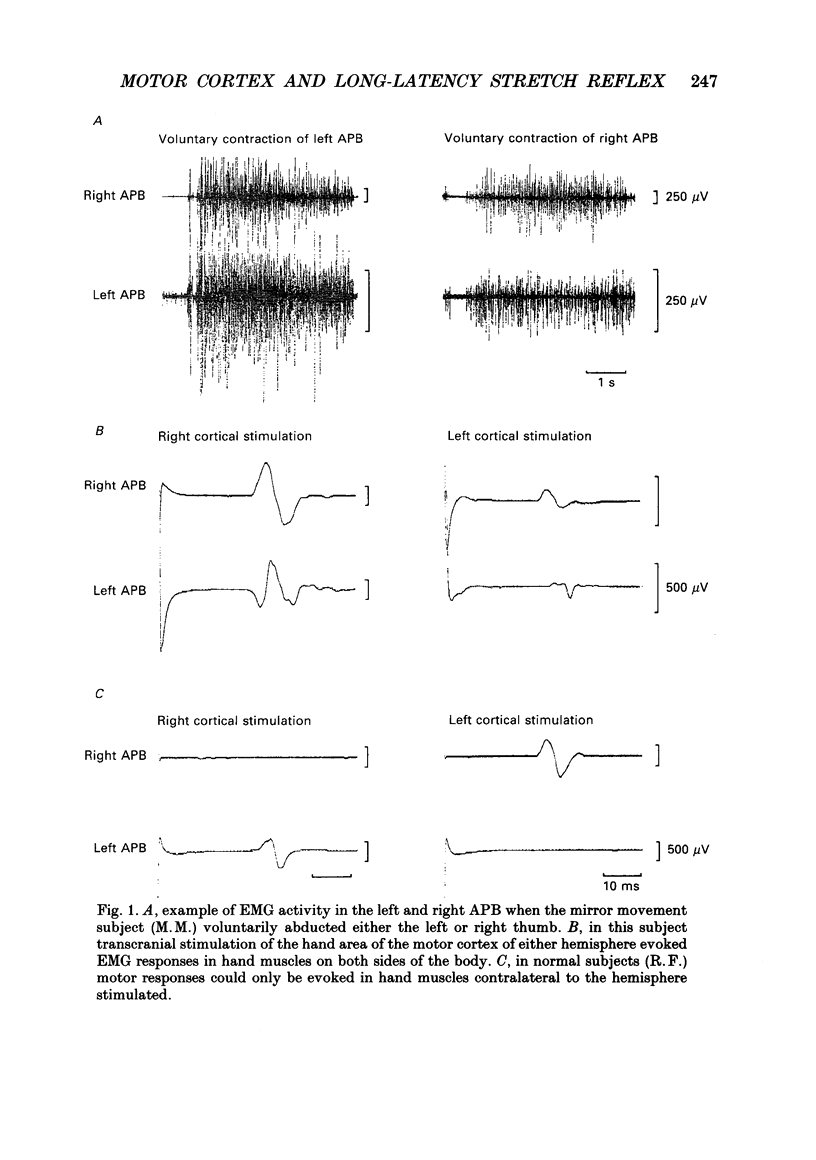
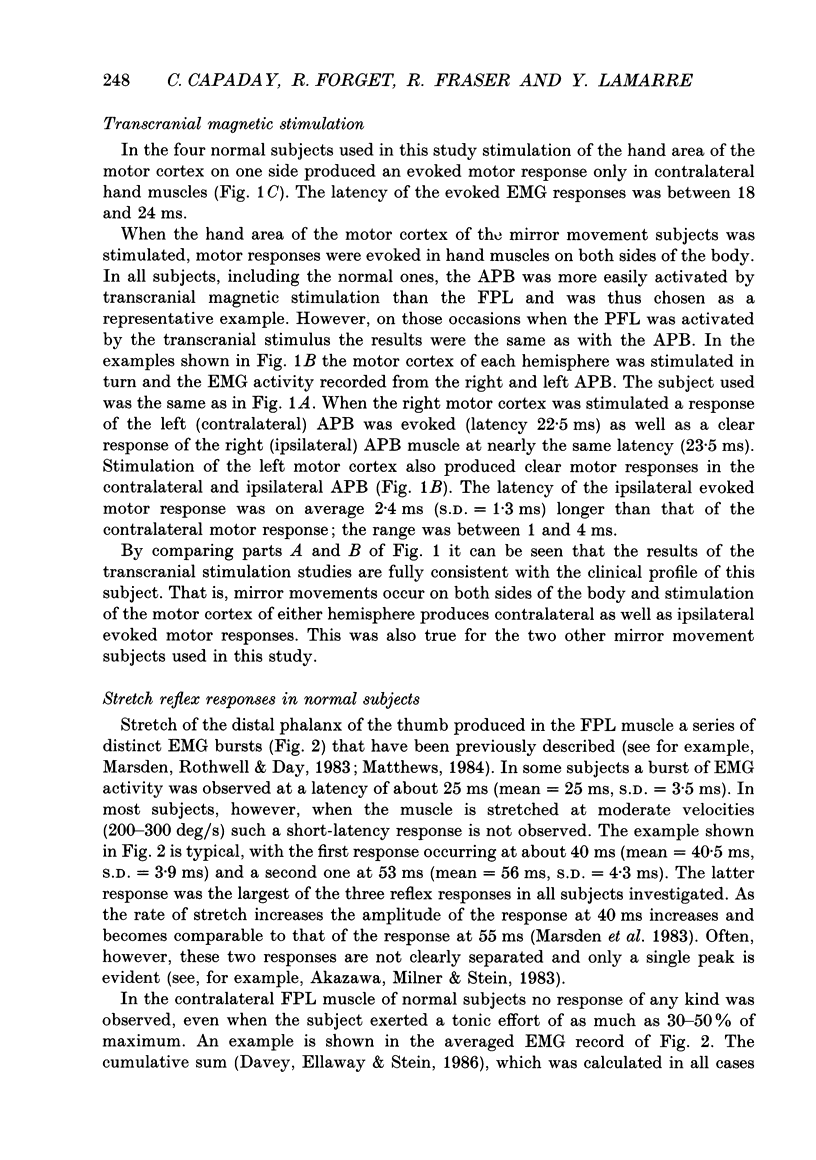
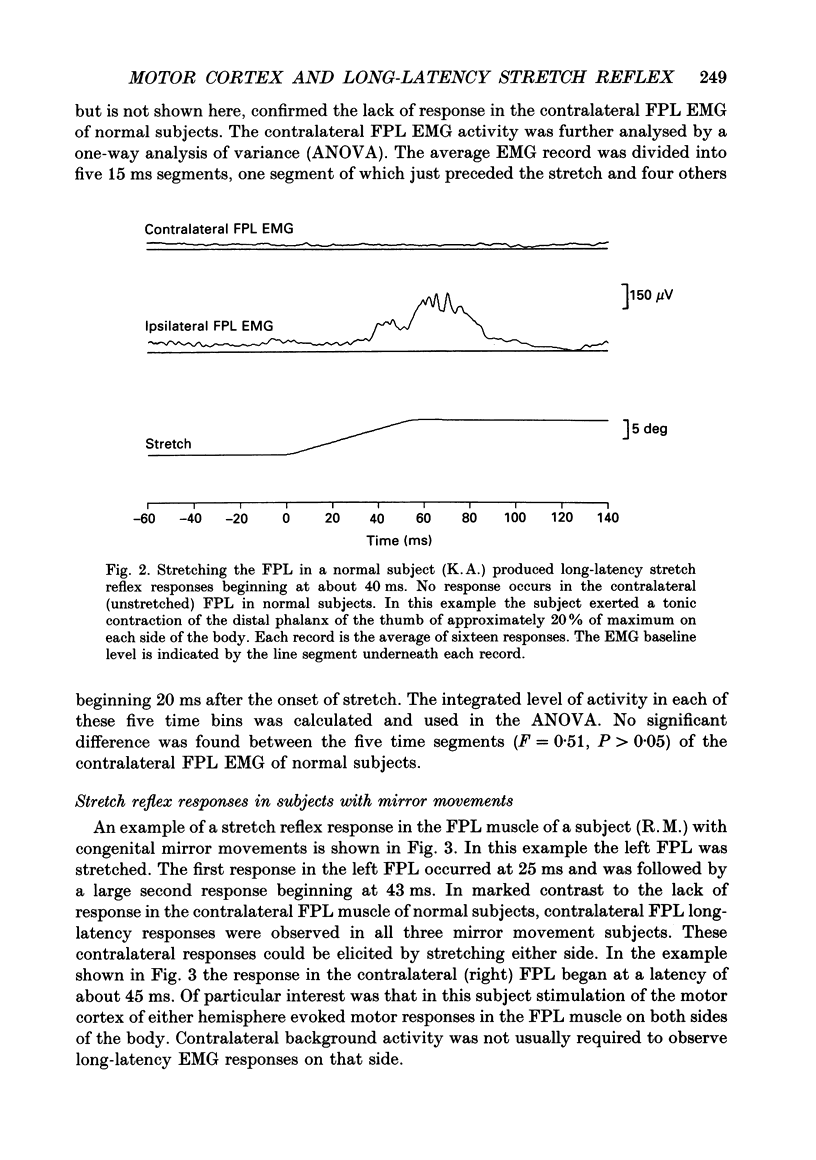
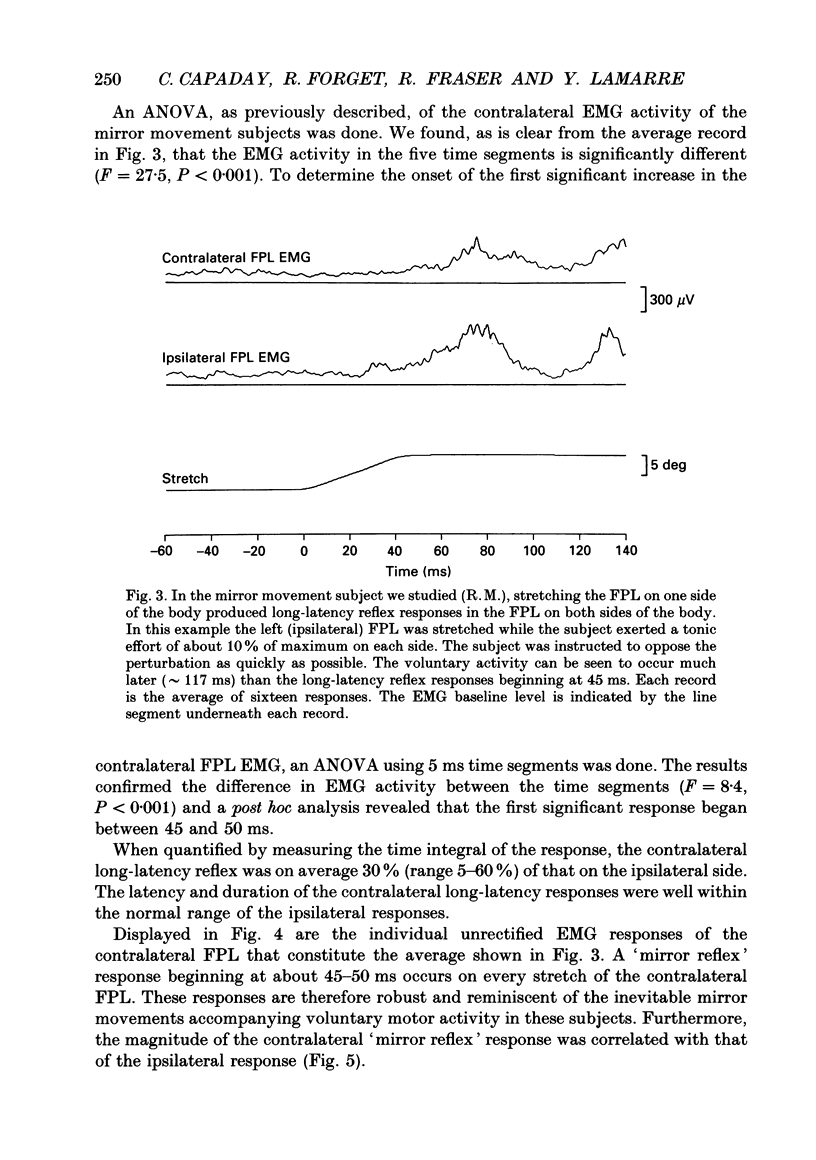
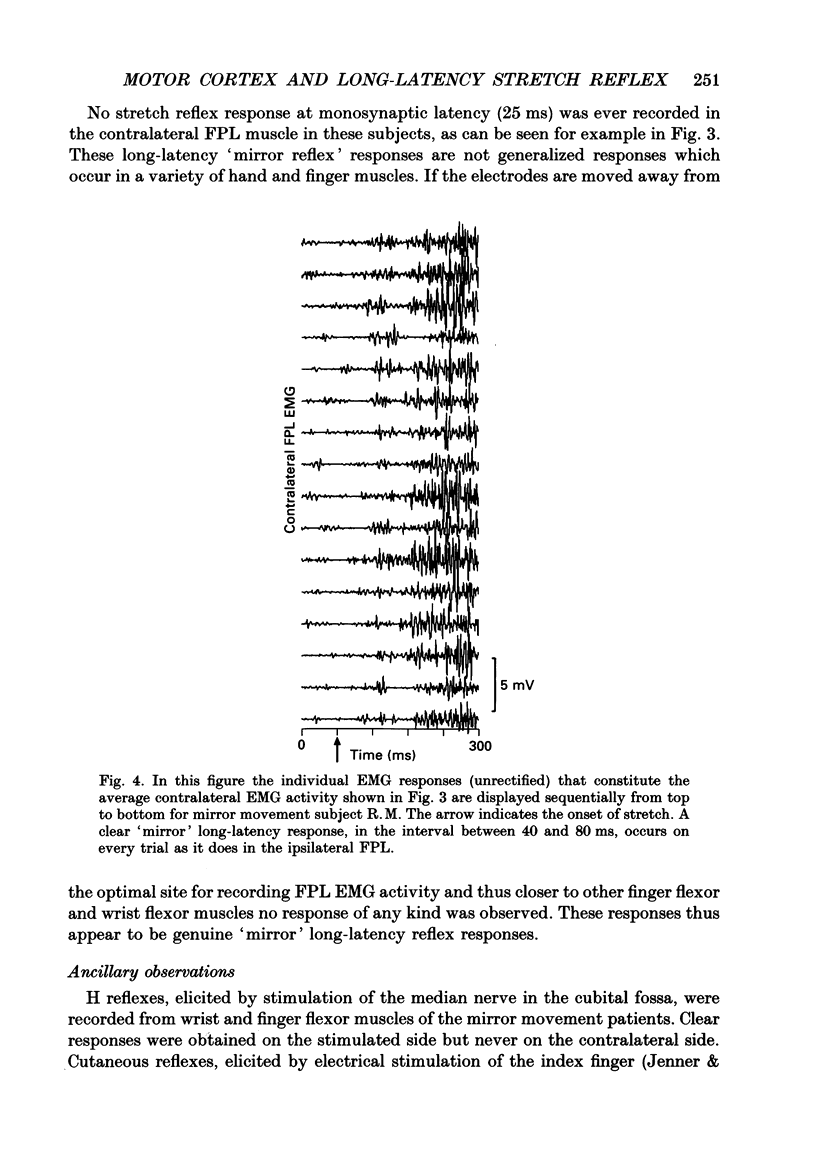
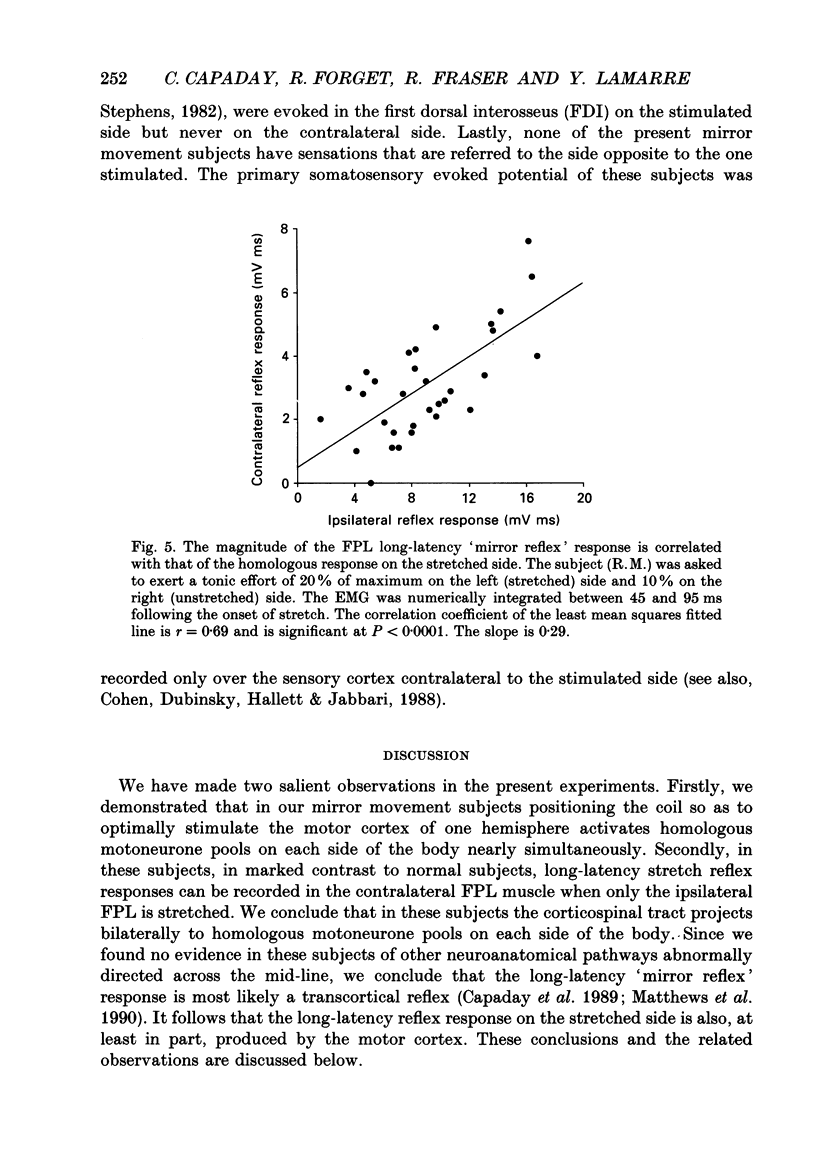


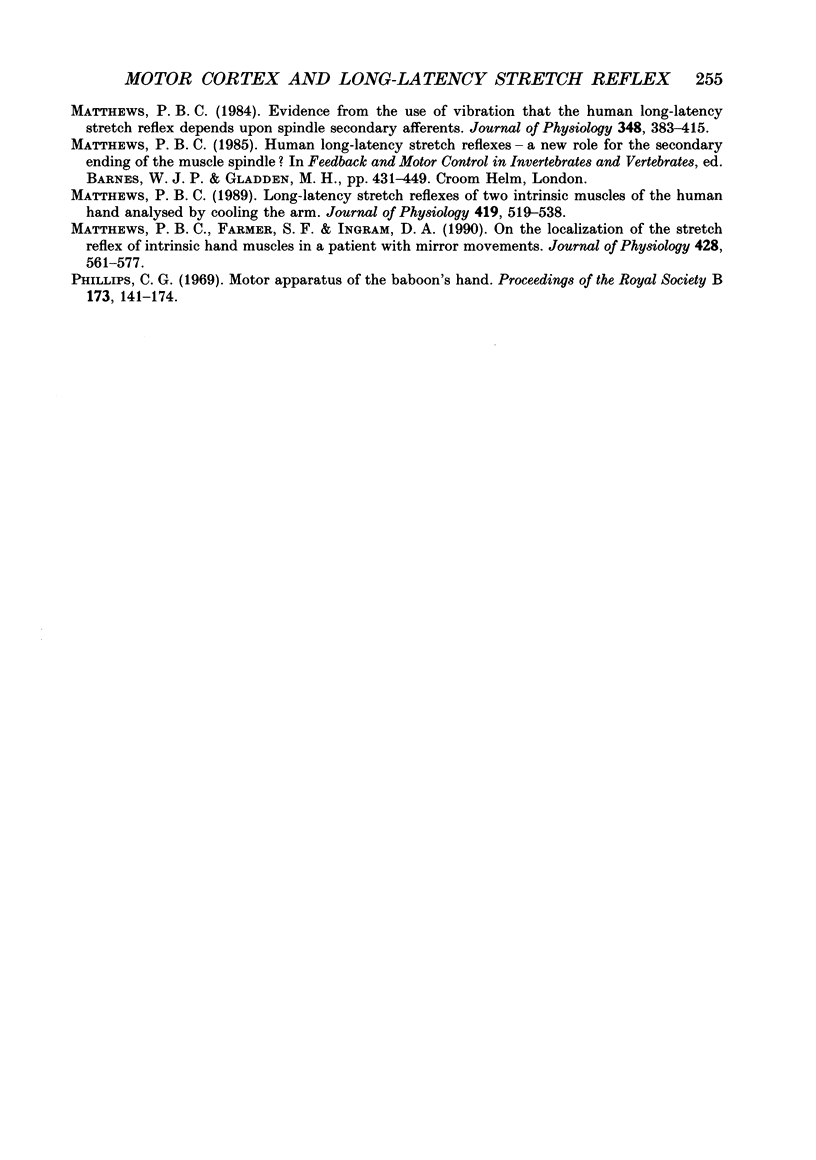
Selected References
These references are in PubMed. This may not be the complete list of references from this article.
- Akazawa K., Milner T. E., Stein R. B. Modulation of reflex EMG and stiffness in response to stretch of human finger muscle. J Neurophysiol. 1983 Jan;49(1):16–27. doi: 10.1152/jn.1983.49.1.16. [DOI] [PubMed] [Google Scholar]
- Cheney P. D., Fetz E. E. Corticomotoneuronal cells contribute to long-latency stretch reflexes in the rhesus monkey. J Physiol. 1984 Apr;349:249–272. doi: 10.1113/jphysiol.1984.sp015155. [DOI] [PMC free article] [PubMed] [Google Scholar]
- Cracco R. Q., Amassian V. E., Maccabee P. J., Cracco J. B. Comparison of human transcallosal responses evoked by magnetic coil and electrical stimulation. Electroencephalogr Clin Neurophysiol. 1989 Nov-Dec;74(6):417–424. doi: 10.1016/0168-5597(89)90030-0. [DOI] [PubMed] [Google Scholar]
- Darton K., Lippold O. C., Shahani M., Shahani U. Long-latency spinal reflexes in humans. J Neurophysiol. 1985 Jun;53(6):1604–1618. doi: 10.1152/jn.1985.53.6.1604. [DOI] [PubMed] [Google Scholar]
- Davey N. J., Ellaway P. H., Stein R. B. Statistical limits for detecting change in the cumulative sum derivative of the peristimulus time histogram. J Neurosci Methods. 1986 Aug;17(2-3):153–166. doi: 10.1016/0165-0270(86)90068-3. [DOI] [PubMed] [Google Scholar]
- Farmer S. F., Ingram D. A., Stephens J. A. Mirror movements studied in a patient with Klippel-Feil syndrome. J Physiol. 1990 Sep;428:467–484. doi: 10.1113/jphysiol.1990.sp018222. [DOI] [PMC free article] [PubMed] [Google Scholar]
- Forget R., Boghen D., Attig E., Lamarre Y. Electromyographic studies of congenital mirror movements. Neurology. 1986 Oct;36(10):1316–1322. doi: 10.1212/wnl.36.10.1316. [DOI] [PubMed] [Google Scholar]
- Hagbarth K. E., Young R. R., Hägglund J. V., Wallin E. U. Segmentation of human spindle and EMG responses to sudden muscle stretch. Neurosci Lett. 1980 Sep;19(2):213–217. doi: 10.1016/0304-3940(80)90197-4. [DOI] [PubMed] [Google Scholar]
- Jenner J. R., Stephens J. A. Cutaneous reflex responses and their central nervous pathways studied in man. J Physiol. 1982 Dec;333:405–419. doi: 10.1113/jphysiol.1982.sp014461. [DOI] [PMC free article] [PubMed] [Google Scholar]
- Lee R. G., Tatton W. G. Motor responses to sudden limb displacements in primates with specific CNS lesions and in human patients with motor system disorders. Can J Neurol Sci. 1975 Aug;2(3):285–293. doi: 10.1017/s0317167100020382. [DOI] [PubMed] [Google Scholar]
- Marsden C. D., Merton P. A., Morton H. B. Servo action in human voluntary movement. Nature. 1972 Jul 21;238(5360):140–143. doi: 10.1038/238140a0. [DOI] [PubMed] [Google Scholar]
- Marsden C. D., Merton P. A., Morton H. B. Servo action in the human thumb. J Physiol. 1976 May;257(1):1–44. doi: 10.1113/jphysiol.1976.sp011354. [DOI] [PMC free article] [PubMed] [Google Scholar]
- Marsden C. D., Rothwell J. C., Day B. L. Long-latency automatic responses to muscle stretch in man: origin and function. Adv Neurol. 1983;39:509–539. [PubMed] [Google Scholar]
- Matthews P. B. Evidence from the use of vibration that the human long-latency stretch reflex depends upon spindle secondary afferents. J Physiol. 1984 Mar;348:383–415. doi: 10.1113/jphysiol.1984.sp015116. [DOI] [PMC free article] [PubMed] [Google Scholar]
- Matthews P. B., Farmer S. F., Ingram D. A. On the localization of the stretch reflex of intrinsic hand muscles in a patient with mirror movements. J Physiol. 1990 Sep;428:561–577. doi: 10.1113/jphysiol.1990.sp018228. [DOI] [PMC free article] [PubMed] [Google Scholar]
- Matthews P. B. Long-latency stretch reflexes of two intrinsic muscles of the human hand analysed by cooling the arm. J Physiol. 1989 Dec;419:519–538. doi: 10.1113/jphysiol.1989.sp017884. [DOI] [PMC free article] [PubMed] [Google Scholar]
- Phillips C. G. The Ferrier lecture, 1968. Motor apparatus of the baboon's hand. Proc R Soc Lond B Biol Sci. 1969 May 20;173(1031):141–174. doi: 10.1098/rspb.1969.0044. [DOI] [PubMed] [Google Scholar]


